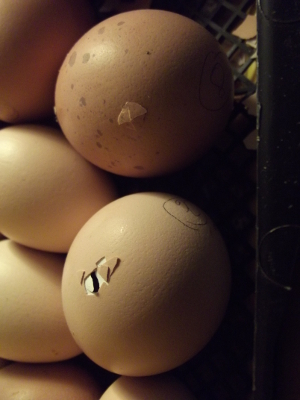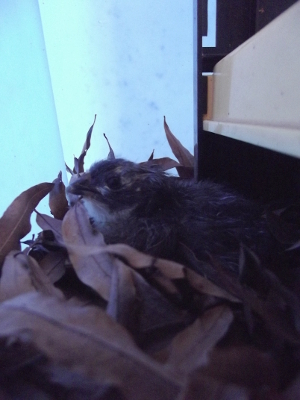
Temperature limits of the Brinsea Ecoglow Brooder
 I
was totally unprepared for our first hatch of the year, for a couple of
reasons. First, our 2011 chicks never seemed to even consider
hopping out of their shells until day 22, which I now figure may be due
to our hatching
eggs being weakened
when they were jostled around by the postal service.
I
was totally unprepared for our first hatch of the year, for a couple of
reasons. First, our 2011 chicks never seemed to even consider
hopping out of their shells until day 22, which I now figure may be due
to our hatching
eggs being weakened
when they were jostled around by the postal service.
Which is all a long way of saying --- I thought I had all day Friday to
get the little indoor brooder ready for chicks so that I could be
prepared for a hatch to begin Saturday afternoon. The tupperware
container was outside, wet and dirty, and the leaves I planned to use
for bedding were still a bit damp.
Second, by this stage of
the winter, I've gotten acclimated to mild cold. Most
of this past week, overnight temperatures only dropped into the
forties, and
I woke to a trailer around 50 degrees Fahrenheit. It hardly
seemed
worth lighting a fire since my morning walk with Lucy warmed my blood
enough to tide me over until the sun came through the trees and heated
the trailer to summer levels. But chicks are less resilient (and
our brooder is only rated down to 50 degrees Fahrenheit with bone dry
chicks and bedding).
So our first chick of
2012 hatched into a household scurrying around to prepare his
brooder. I set Mark on cleaning out the brooder while I watched
the tiny ball of fuzz push its way out of the shell.
Last year, I got into
the habit of moving chicks out of the incubator nearly immediately
rather than waiting until they dried off fully since I didn't like
newly hatched chicks rolling the unhatched eggs around. So, half
an hour after hatch, I plucked out our hatchee and popped him under the
Brinsea
Ecoglow Brooder.
 Peep, peep, peep. The peeping got worse
and worse until I was tearing out my hair. I thrust the chick
back into the incubator, lit a fire in the woodstove, and turned on a
space heater, all at the same time. (At least the chick didn't
end up in the stove.) Then, half an hour later, I tried Operation
Chick Move again.
Peep, peep, peep. The peeping got worse
and worse until I was tearing out my hair. I thrust the chick
back into the incubator, lit a fire in the woodstove, and turned on a
space heater, all at the same time. (At least the chick didn't
end up in the stove.) Then, half an hour later, I tried Operation
Chick Move again.
Peep, peep, peep. Boy, that chick
wasn't a happy camper, and neither was I. With some trepidation,
I set the brood box up on top of the space heater and ran to get Mark's
input.
Peep,
peep, PEEP. The chick was still
yelling his head off, so Mark
added another space heater to increase the temperature inside.
Peep, peep, peep, peeeep.
Finally, peace and quiet! Lesson learned --- homegrown eggs might
pop open on day 20 and early spring chicks need some extra heat beyond
the Brinsea brooder during the drying off period. And here I
thought I was such an old hand that there wouldn't be any drama during
the hatching period. Stay tuned to hear the stats on the rest of
the hatch.
Want more in-depth information? Browse through our books.
Or explore more posts by date or by subject.
About us: Anna Hess and Mark Hamilton spent over a decade living self-sufficiently in the mountains of Virginia before moving north to start over from scratch in the foothills of Ohio. They've experimented with permaculture, no-till gardening, trailersteading, home-based microbusinesses and much more, writing about their adventures in both blogs and books.
Want to be notified when new comments are posted on this page? Click on the RSS button after you add a comment to subscribe to the comment feed, or simply check the box beside "email replies to me" while writing your comment.

This one is rated for 20 chicks, but they make one for 50 (which is more expensive.) I haven't had any problem with chicks getting cold --- as they outgrow it, they also become better at regulating their internal temperature, so fewer of them need to be under it at the same time. That said, I may be tougher on my chickens than you are --- no way would I give them supplemental heat beyond week three when they're fully feathered.
And I also haven't raised any in really cold weather yet. This batch will be pushing that boundary, and I'll be sure to let you know if they get cold.
I have no help to offer but childhood memories. I do remember our chicks peeping their heads off until they were dry. Thanks for bringing back those memories. It's much enjoyed (stuck in urban-land with a very old and small lot so no chickiees for me).